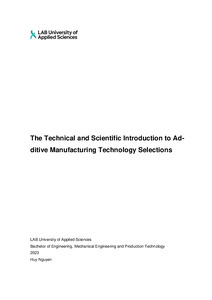The technical and scientific introduction to additive manufacturing technology selections
Nguyen, Huy (2023)
Nguyen, Huy
2023
All rights reserved. This publication is copyrighted. You may download, display and print it for Your own personal use. Commercial use is prohibited.
Julkaisun pysyvä osoite on
https://urn.fi/URN:NBN:fi:amk-202304286920
https://urn.fi/URN:NBN:fi:amk-202304286920
Tiivistelmä
The purpose of the thesis was to investigate the accuracy and resolution of three-dimensional (3D) printers. The research aimed to answer the inquiry: "How to select the suitable additive manufacturing (AM) methods?".
The research employed a quantitative approach and incorporated primary and secondary data. The primary source was collected by printing and measuring the artefacts. The secondary source was gathered by utilising online sources and published literature.
The subsequent topics were addressed in the study: the introduction, the evolution, and the application of AM technology, and the review of previous research on the geometric performance of AM process. When analysing the AM technology, the thesis focused on the working principle and design guidelines of Material Jetting (MJ), Fused-Deposition Modelling (FDM), and Stereolithography (SLA) technology. The empirical was conducted by analysing the measurements of printed specimens.
To conclude, the result presents that the MJ and the SLA printer are more suitable for producing fine features (less than 5.0 mm) than FDM printers.
The research employed a quantitative approach and incorporated primary and secondary data. The primary source was collected by printing and measuring the artefacts. The secondary source was gathered by utilising online sources and published literature.
The subsequent topics were addressed in the study: the introduction, the evolution, and the application of AM technology, and the review of previous research on the geometric performance of AM process. When analysing the AM technology, the thesis focused on the working principle and design guidelines of Material Jetting (MJ), Fused-Deposition Modelling (FDM), and Stereolithography (SLA) technology. The empirical was conducted by analysing the measurements of printed specimens.
To conclude, the result presents that the MJ and the SLA printer are more suitable for producing fine features (less than 5.0 mm) than FDM printers.
